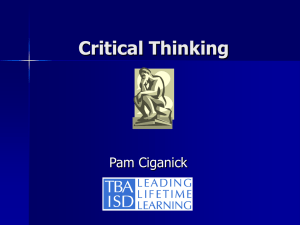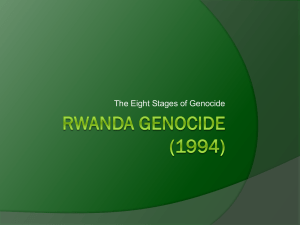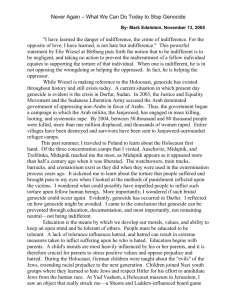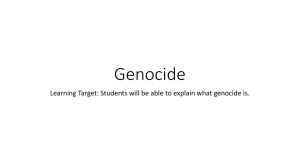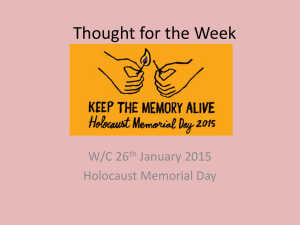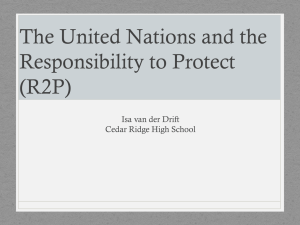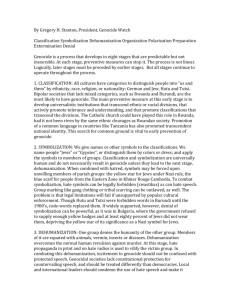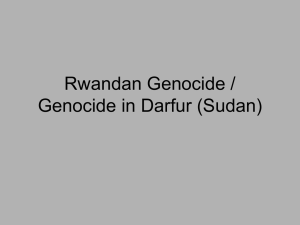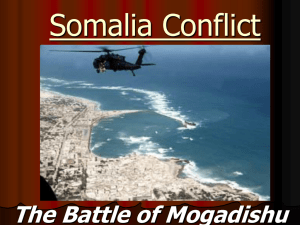PPT
advertisement
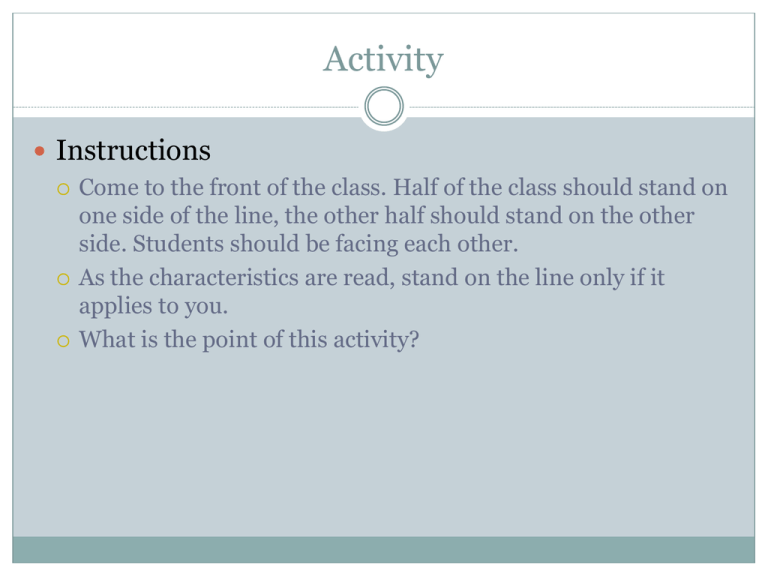
Activity Instructions Come to the front of the class. Half of the class should stand on one side of the line, the other half should stand on the other side. Students should be facing each other. As the characteristics are read, stand on the line only if it applies to you. What is the point of this activity? Discuss! • What would society be like people were discriminated against based on these categories? • What if, for example, people who could not touch their toes were deemed less intelligent than those who could? • Or if people with long fingernails were prohibited from owning property? Would it be fair? Would there be any justification? • How do these categories relate to marked differences in today’s society? What is seen as the norm/difference? Systematic Discrimination and Genocide HSB4M – CHALLENGE AND CHANGE IN SOCIETY Put on your thinking caps! American educator Peggy McIntosh has coined the phrase “an invisible weightless knapsack of special provisions, maps, passports, codebooks, visas, clothes, tools and blank checks.” What does this mean? What could this refer to? Article: Unpacking the Knapsack What Causes Hate? • What causes hate? Reasons? Justifications? • We often find it difficult to understand the level of hatred directed at certain people or cultural groups in society In December 1989, a Montreal man gunned down 14 female students at the Ecole Polytechnique in Montreal – In 1998, White Texans dragged a black – man to his death behind their pickup truck – The World Trade Centre was attacked by terrorists killing more than 3000 people – Four Characteristics of Hate Crimes • The hatred is intense and impersonal – The hatred is not directed at individuals but is instead directed at unknown people, or people who represented the group the person hates • The hatred is based on prejudice and power – Stereotypes can harden into feelings of prejudice which can then lead to discriminatory actions – Usually the perpetrators of these actions have some power or authority over their victims – strength of numbers, surprise etc. Characteristics continued... • The Hatred is directed at scapegoats for other frustrations – – – Allport suggests that frustration and the difficulties of life may be found at the centre of intense hatred toward out-groups (ie. Affirmative action) People singled out for these hostilities are called scapegoats Usually these scapegoats are easily identifiable minority groups that people in power can lay blame and act out their aggressions on them Characteristics continued... Genocide is an expression of national hatred The greatest excesses of hatred directed against minority scapegoats are those that are carried out by order as national policy Adolf Hitler ranted about his hatred for Jews in his book Mein Kampf while he was incarcerated In his book he blamed the Jews for all the failures in his own life Genocide "genocide“: the systematic extermination of a nationality or group Combines Greek “geno” meaning “race” or “tribe” with the Latin “cide” from “cadere” meaning “killing” This term was coined by Raphael Lemkin as a direct result of the Holocaust. Characteristics of Genocide • Genocide, as defined by the United Nations in 1948, means any of the following acts committed with intent to destroy, in whole or in part, a national, ethnic, racial, or religious group, including: – – – – – Killing members of the group Causing serious bodily or mental harm to members of the group Deliberately inflicting on the group conditions of life calculated to bring about its physical destruction in whole or in part Imposing measures intended to prevent births within the group Forcibly transferring children of the group to another group Pyramid of Hate The Holocaust • the annihilation of the Jews and other groups of people of Europe under the Nazi regime during World War II • 11 million people exterminated, 6 million Jews • Shot, starved, gassed, burned, worked to death • Stripped of rights, segregated, put into concentration camps, exterminated • “life unworthy of life” The Holocaust: Factors of Hate – – – – – – – – – Stripped of German citizenship Banned from German schools/universities Forced to carry ID cards Jewish synagogues destroyed Forbidden marriages between Jews and Aryans Possessions were confiscated Heads shaved, arms tattooed Men, women, children were separated Inhumane medical experiments International Response • National governments and world leaders have been criticized for their failure to take action which could have saved millions • Pope Pius XII did not publicly speak out against the murder of the Jews during the Holocaust – the Vatican did take some action to save many Jews in Italy from deportation by sheltering several hundred Jews in the catacombs of St. Peter's Basilica • International Committee of the Red Cross did little to save Jews – Suggested that by aiding Jewish prisoners would harm its ability to save other Allied POW’s, threat to Switzerland The Rwandan Genocide Mass killing of hundreds of thousands of Rwanda's Tutsis by the Hutu dominated government Lasted approximately 100 days Estimated death toll ranged between 500,000 and 1,000,000 The Rwandan Genocide: Factors of Hate given ID cards which specified an ethnic group lighter coloured Rwandans were Tutsi – minority darker skinned Rwandans were Hutu – majority Tutsi men, women, children were separated Sometimes forced to be Hutu slaves Tutsi women were often referred to as "gypsies" and frequently fell victim to sexual violence Hutu civilians were instructed to kill their Tutsi neighbours or be killed International Response • The U.S. government was reluctant to involve itself in the "local conflict" in Rwanda and refused to label the killings as "genocide” • Clinton stated that he believes if he had sent 5,000 U.S. peacekeepers, more than 500,000 lives could have been saved • The U.S. refused to jam extremist radio broadcasts inciting the killing, citing costs and concern with international law • U.S. officials knew exactly who was leading the genocide, and actually spoke with those leaders to urge an end to the violence but did not follow up with concrete action Spotlight The Promises of the UN • When the Genocide Convention was passed by the United Nations in 1948, the world said, "Never again." • The promise the United Nations made was broken, as genocides and other forms of mass murder killed 170 million people, more than all the international wars of the twentieth century combined Activity: Spotlight and Case Study • The Armenian Genocide • The Darfur Genocide • The Apartheid in South Africa Activity Read the case study you have been assigned Pull out characteristics from the Pyramid of Hate that are relevant within the case study Highlight the characteristics! Meet with your group- discuss! Debrief Class discussion regarding genocide, human rights, acknowledging “us” versus “them” History Repeats Itself Consider the widely held belief that it is important to learn from the mistakes of the past in order to ensure we don’t repeat them. Why didn’t the lessons learned from the World War II Holocaust (over 50 years ago) prevent the Rwandan genocide (15 years ago) or the current genocide occurring in Darfur? “Us” versus “Them” Why is it easier to look at examples of genocide in other countries than atrocities occurring in own backyard (i.e., human rights violations against Aboriginal groups in Canada)? Making a Difference Why is there guilt associated with genocides like Rwanda? i.e., think of all the countries, including Canada, that knew what was happening Is there a way that this generation of youth can make a difference?
